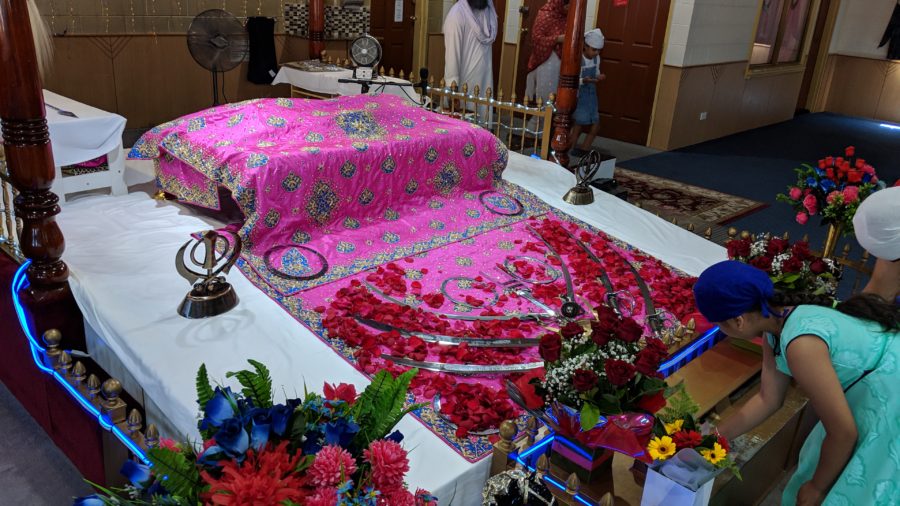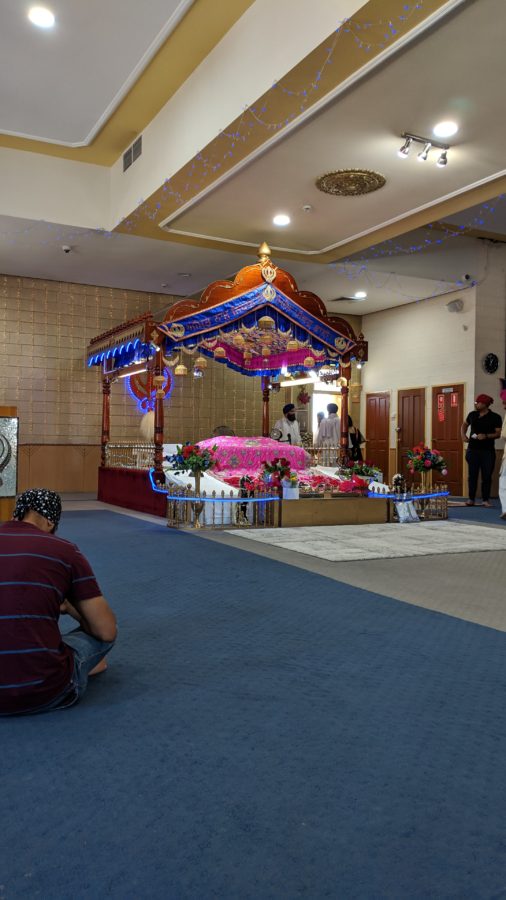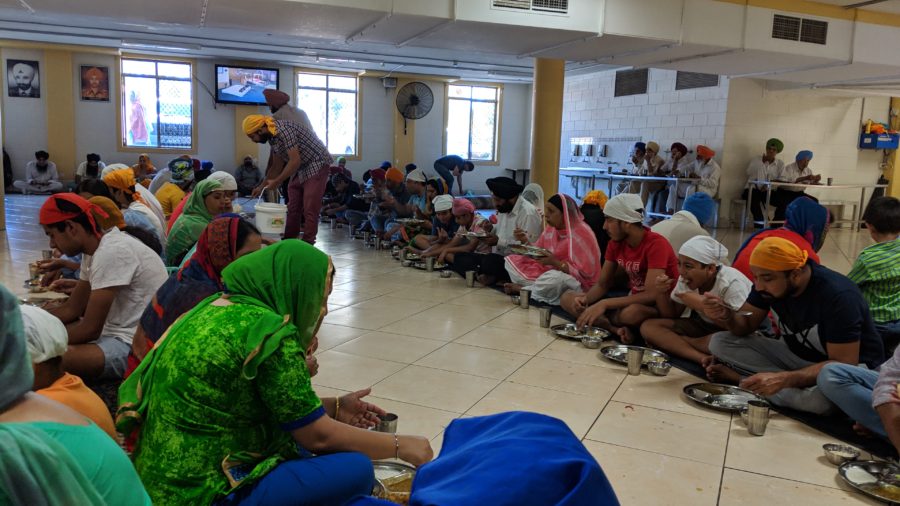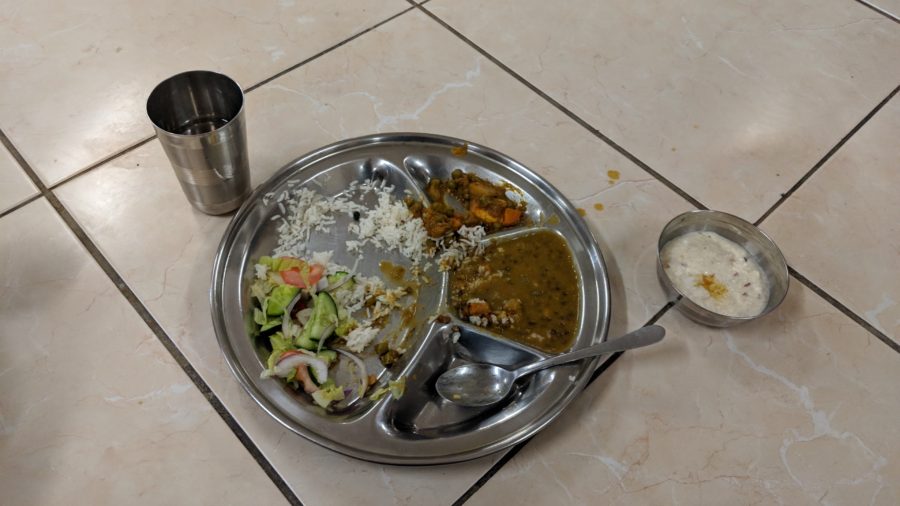This is part two of my Beyond Belief project, where every month during 2019 I plan to experience a different religion that I know nothing about. This month its Sikhism. I have to admit, this one I knew absolutely nothing about.
There is a large temple-looking place not far from where I live so I dropped in the other day to see what it was about. Turns out it is a gurdwara, which is a temple for Sikhs. The only thing I really knew about Sikhs was that they typically come from Northern India and they wear turbans (at least the men do). I’d never really thought that being Sikh was a stand-alone religion, and just assumed it was some offshoot of Hinduism. That’s definitely not the case.
When I dropped into the gurdwara to take a look, there was a guy with a beard and turban near the entrance measuring up a noticeboard, so I approached and explained that I am trying a different religion every month this year. He put down his measuring tape, then spent the next 90 minutes showing me around, explaining the religion and telling me about the beliefs. His name was Padam, and he was super helpful. He pointed out the large TV screen near the entrance that displayed a piece of scripture for the day, and Iearned that it came from the Guru Granth Sahib, which is the Sikh holy book. It displays a different piece of scripture each day, which is made available from “the opening” of the book at 4am each morning, until 8pm each night. Padam suggested that if I read it, it would contain a personal message that I needed to hear because of me turning up on this day at this time. I read it and maybe I just missed it, because I’m not sure I gleaned anything particular. Maybe it’s just me.
I took off my shoes and put on a head covering and we went into the gurdwara, knelt in front of the holy area where the Guru Granth Sahib was kept, and Padam told me lots and lots of stuff about the Sikh religion.
He stressed that the Sikh religion is extremely egalitarian, and treats every human with respect and reverence. A good Sikh, he told me, is peace-loving and is blind to race, to colour, to nationality, to gender. Every human, regardless of who they are, is equal and welcome. Sikhs are welcoming to all other religions, and even though they have been persecuted and even executed over the centuries by Muslim and Mughal invaders, they still harbour no ill feelings towards other religions or races.
I learned that the word “Sikh” actually translates as “learner”. Does that make me a Sikh? Probably not. But I was definitely learning. I learned that Sikhism is a monotheistic religion (one god) but that god is a universal god, acknowledged as the same spiritual creative force as recognised by other religions. The message of this god is communicated through Gurus, starting with the first one, Guru Nanak in the 1500s, and then a succession of other Gurus who became the messengers of this god on earth. The holy book, the Guru Granth Sahib, was steadily edited and extended by the successive line of gurus that followed, each adding more wisdom to it. I asked Padam who the current living guru was and he pointed to the book, which I didn’t really understand right away, but it turns out that the tenth guru, Guru Gobind Singh, named the book as his successor, and the book itself has been “the Guru” ever since. (India is famous for outsourcing, but I never expected something like this!) The book is treated as a real living human person, complete with a real funeral when a copy gets too old to keep using.
The other thing I learned about was “The 5 Ks”, or the symbols that every practicing Sikh carries with them at all times. They are kēs (uncut hair, which is why most Sikh men have beards and under the turban usually long hair), kaṅghā (a small wooden comb kept in the hair), kaṛā (circular steel or iron bracelet designed to both represent the eternal nature of god, but also to represent a handcuff, connecting them to god), kirpān (a small sword or dagger carried on their person. Padam said that Sikhs have special permission to carry the dagger under Australian law), and kacchera (the special underpants designed to remind them of chastity and faithfulness).
Things must come in fives because there are also five things that Sikhs try to avoid. They are referred to as the “Five Thieves” – Lust, Anger, Greed, Attachment, and Ego. Padam spent quite a bit of time explaining the meaning of these and the effect it has on the way they approach life, but I probably can’t do it justice in this blog post, which is already getting long! The wikipedia article about Sikhism is very good if you want to learn more.
Before I left, Padam invited me to come back on Sunday to experience part of the Kirtan certemony and stay for Langar. I turned up at about 12:00pm and sat in on the holy prayers being sung, then the scriptures being read, before heading downstairs to join Langar. Langar is a community meal, provided free to anyone who turns up. You sit on the floor with rows of other people, with a large metal dish in front of you, and people come around and put food on it. It’s all vegetarian, with dhaal, flatbread, rice, aloo, and salad. It’s quite the communal experience.
So that’s my investigation to Sikhism. It struck me as a really nice religion that has a whole lot of interesting traditions, history and beliefs, and some very friendly and welcoming people. I’m not about to convert (to this or any other religion) but I’m glad I checked it out and know a little bit more about it now.
Now, which religion will I try next month? Leave a comment with your ideas! Also, I’d love your comments on this project of trying a different religion each month. Is it a good idea? A dumb idea? Is there something you think I should do differently?
![]() February – Sikhism by Chris Betcher is licensed under a Creative Commons Attribution 4.0 International License.
February – Sikhism by Chris Betcher is licensed under a Creative Commons Attribution 4.0 International License.









Really interesting Chris! A big departure from the EdTech side I signed up for, but love the insights. I am a member of the Church of Jesus Christ of Latter-day Saints and served as a missionary for 2 years (long time ago!) so I hope you get to check us out. Missionaries leave their homes and serve for 18/24 months at their own cost, leaving behind family, friends, study, career etc to share the Gospel and teach people about what we believe. It is the only “restored” Christian Church that does not trace its roots back to the Catholic Church. Anyway I will leave the investigation to you. All the best, your presentations back in IWB days were awesome!
Hey Greg!Thanks for the feedback. Yes a bit of a departure from all of the usual edtech stuff I typically write about I know. I appreciate you sticking around regardless.
One of the things that has really dawned on me over the last couple of years is how as people we are all so much more than our own narrow set of interests. I still love education and technology and ideas, which was the founding theme of this blog, but it’s so easy to become immersed in our own specialised worlds that we can become a little blind to the huge diversity of other things out there. Over the last little while I’ve been deliberately trying to learn new things, explore new ideas, and live new experiences that are outside the sphere of what I’d normally do. I always said this blog was just my place to think out loud, share and reflect about life… It just so happened that for many years most of that was around edtech (and I’m sure it will continue to be too!) but it’s been fun branching out into other less expected areas like this.
Thanks for the suggestion about the 7DA Church. It’s a good one. I don’t know much about Mormons other than what I learned from seeing the musical and I’m sure there’s much more to to it than that. I know it’s a fascinating religion so thanks, I’ll check it out. Plus, you guys also have the special underpants so that is yet another good reason to learn more!
Thank you for being a reader.
Chris
Hey Chris… I remember a while back you did a creativity challenge every day for a year which sounded damn hard! Props for getting outside the comfort zone – again. The Book of Mormon musical is coming to Perth so should generate some good discussions! Yes there is a lot more to it than the musical. Underwear – here is something on that https://youtu.be/5vvN4qJRBM0
G’Day Chris,
Interesting post and project. You’ve ventured into my area I see. One point of clarification about the Sikhs is that only those who have undergone the ritual called Baptism of the Sword are required to adhere strictly to the 5 K’s, there are Sikhs who cut their hair and shave their beards. Some Sikhs who are not baptized follow the 5 K’s or at least some of them. Also my understanding is women can wear the turban if they so choose although this, from my experience, is rare.
Looking forward to your next adventure.